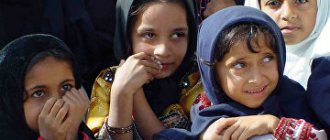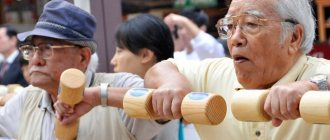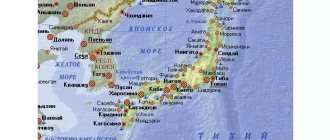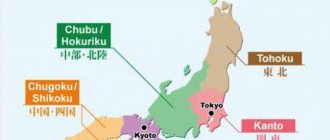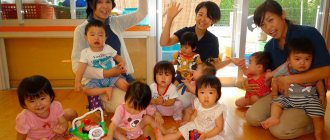The peculiarities of the geographical location and historical development of Japan have had a significant impact on the current situation of the state in general and on the population in particular.
The specifics of the Eastern mentality and the relative isolation of the state influenced the formation of the national composition of the country, the life expectancy of the Japanese, their attitude towards family, their traditions and culture.
Geographical location of Japan
Geographically, the state consists entirely of islands located in the eastern part of Asia.
97% of the area is formed by the largest of them:
- Honshu;
- Hokkaido;
- Kyushu;
- Shikoku;
- Okinawa.
The remaining 3% is made up of groups of Pacific islands: Nampo, Izu, Ogasawara, Kazan and others.
History of development
With the rise to power of a military government in the 17th century, the Tokugawa Shogunate, Japan maintained a policy of closed borders that lasted two centuries. As a result, by the mid-19th century the country was a fragmented, closed agricultural periphery. By this time, it had become impossible to ignore global development trends and the penetration of Western republics into the region.
The deterioration of the internal economic and social situation led the country to a coup - the Meiji restoration (enlightened rule).
From this moment on, a new stage in the historical development of Japan begins, associated with the following factors:
- The abolition of the shogunate and the return of the power of the monarch.
- Opening borders: introducing Western technologies, developing foreign trade relations.
- Reorganization of the army and navy along the lines of Germany and Great Britain.
- Reforming the internal situation of the country.
This policy brought the country to the position of a developed world power by the beginning of the 20th century. The position of the aggressor in the Second World War and its consequences (destruction, indemnity, loss of territories, military power and independence) threw the country back from the general line of development for some time. This made its own adjustments to the history of the country.
In the post-war period, all funds were spent on restoring the state, and not on the arms race and participation in military clashes of the Cold War. The result was record economic growth in the 50-70s of the 20th century. The Japanese economic miracle returned the country to a place among world leaders that remains to this day.
Area and boundaries
The area of the country is represented by the sum of all its constituent islands and water surfaces. This number is 377,930 sq. km.
Where Japan is located on the world map shows us the complete absence of land borders.
The closest neighbors are separated by seas and straits:
- China - East China Sea in the southwest;
- Korea - the Sea of Japan in the west;
- Russia (Sakhalin Island and the Kuril Islands) - the La Perouse Strait and the Kunashir Strait in the north.
Capital
The main city of the country is Tokyo, located on the largest and most populous island of Honshu. More than 13 million people live here.
Tokyo is the center of:
- production of high-tech science-intensive products;
- the location of the main offices of international foreign corporations;
- education;
- finance (one of the largest stock exchanges in the world is located);
- politics and administration.
Political regime
Japan is a democratic state with a constitutional monarchy form of government. This implies the nominal supremacy of the emperor, whose role is to perform representative functions.
The de facto head of state is the Prime Minister, head of the Cabinet of Ministers, the country's executive body.
The expression of the will of the people, the holder of legislative power and the bearer of state sovereignty is the parliament.
The composition is represented by two chambers:
- House of Representatives, consisting of 480 deputies elected for 4 years.
- The House of Councilors, consisting of 242 deputies elected for 6 years.
State symbols
The flag of Japan is a red circle on an azure background. It is a symbol of the country's rise in the 19th century. Along with the anthem and flag, the seal of the emperor is a state symbol. Her imprint is a chrysanthemum with 16 petals.
Japan also has many officially recognized symbols of the country associated with animals, plants and nature.
First of all this:
- Mount Fuji;
- sakura;
- Japanese stork;
- Tanuki (raccoon dog), etc.
The language of the country is absolutely special, having several dialects. It is considered one of the most difficult; it can take a whole year to learn just the alphabet and counting system. The hieroglyphic writing, which is unusual for the European eye, is especially difficult to perceive.
The country's official currency is the yen, which is one of the world's reserve currencies. Japanese money is represented by coins and paper bills. The smallest coin is one yen, the largest bill is 10,000 yen, or one mana.
Economy
Rapid economic growth 50-70. not without government intervention. But at present, such trends cannot solve the crisis, so it is proposed to weaken the regulation of foreign exchange and financial markets, privatize the public sector, etc.
Financially, Japan is a global creditor, plays a leading role in the world and has a dominant position in Asia. On economic issues, Japan maintains an active dialogue with the US President.
In terms of production, the resource-poor country occupies a leading position in industry.
The leading industries here are:
- robotics;
- electronics;
- machine-tool, machine-tool, shipbuilding.
Agriculture is represented by rice growing and fishing. The country is a leader in the production and processing of fish and seafood in the world.
Relief and climate
The volcanic and mountainous origin of the islands, the constant movement of the tectonic plate leads to frequent earthquakes in the region.
The climatic zone is represented by four distinct seasons.
Depending on the territory, temperature fluctuations occur on average:
- From –15 °C in the north of Hokkaido, to +16 °C on the southern islands in winter.
- From 25 °C in the north, to 30 °C in the south - in summer.
The weather in Japan is influenced by its island position, proximity to the ocean, high humidity and seasonal winds.
Culture and life of the peoples of Japan
The culture of modern Japanese is the subject of close attention of ethnographers and simply enthusiastic individuals. The characteristic post-frame dwellings with paper or cardboard walls, raised floors on stilts and tatami mats are one of the symbols of Japan.
The Japanese are distinguished by their special aestheticism and the concept of utilitarian aesthetics. In their worldview, every item should be as simple, beautiful and functional as possible.
Many cultural phenomena are unique and characteristic only of the Japanese - origami paper sculpture, the art of arranging bouquets of ikebana, national clothing kimono, theatrical, musical and visual arts. Every manifestation of Japanese culture and life is a phenomenon that requires detailed consideration.
The origins of the Ainu people remain a mystery. These people have little in common with any people inhabiting the Far East and the Pacific Islands. Modern Ainu are indistinguishable from the Japanese, although they are recognized as a national minority. Their ancestral culture was based on hunting, gathering and fishing. The spiritual aspect of life lay in animalism and magical rituals of sacrifice. Characteristic features are thick beards and mustaches for men and ritual lip tattooing for women.
The Ryukyuan people are the largest Japanese minority. This is the indigenous people of the archipelago, which has not left its borders since its inception. The human skeletons of Minatogawa, dated 16-14 millennium BC, belong to the ancestors of the Ryukyuan people.
Traditions and customs
The culture of the Ryukyus people developed under the influence of neighboring peoples, absorbing a lot of their features. But there are also a number of assets that have become traditional, which arose without outside help:
- martial arts karate, kobudo, tegumi;
- the musical instrument sanshin, on the basis of which the shamisen was created;
- dyeing fabrics using the bingat method;
- poems in the ryuk genre.
The indigenous people of Okinawa have created many other individual cultural phenomena that have become part of their customs since ancient times. The Ryukyu religion is similar in many ways to Shintoism. It also features sacred places and the worship of their spirits. However, modern Ryukyusans no longer actively profess their canons.
The modern customs of the Yamato Japanese, Ryukyus and Ainu are indistinguishable due to the complete assimilation of the population. Ainu rituals demonstrated in thematic museums are more of an entertaining nature and are aimed at tourists. The remaining Ainu and Ryukyus themselves, together with all the Japanese, celebrate obon in honor of the remembrance of the dead, and they also organize tea ceremonies and wedding ceremonies.
How are the Japanese different?
The Japanese are characterized by workaholism, pedantry and scrupulousness in their work. Although the working day in the country is officially eight-hour, few people comply with this norm. Employees often stay at work for 12 hours.
A peculiarity of their appearance is the average height of the Japanese, which differs from the European one. At the beginning of the 20th century it was 150 cm for men and 145 cm for women. Today there is an increase in this figure - the average Japanese reaches 170 cm.
Population
Since the 70s of the 20th century, negative trends have been observed in the demographic issue. Natural population growth gradually fell, and since 2011 it has become negative.
Number and density
At the end of 2021, Japan's total population was 126.087 million.
The distribution of people across the main islands is extremely uneven:
- Honshu. Population: 103 million people. Density: 447 people per square kilometer.
- Hokkaido. Population: 5.6 million people. Density - 64.5.
- Kyushu. The population is 12 million people, with a density of 371 people per square kilometer.
- Shikoku. Population: 3.9 million people. Density - 220.
The average population density in the country is 333.6 people per square kilometer.
Men and women
In the country, the female population slightly exceeds the male population. Their number is 61.39 million men, 64.66 million women.
In percentage terms it looks like this:
- 48.7% men;
- 51.3% women.
Mortality and fertility
Over the past seven years, natural population growth has been negative. Its performance from 2011 to 2021 decreased from -0.03% to -0.12%.
The number of births over the past year is 199,508 people, deaths - 241,143 people.
Religions
Japan is a non-religious country. The number of atheists and those who do not adhere to any religion exceeds half of the population, namely 57%. The most numerous religion is Buddhism, it has more than 45 million followers, accounting for 36% of the population.
Adherents of other faiths were distributed as follows:
- Christianity - 1.6% of the country's population;
- Islam - 0.2%;
- folk beliefs - 0.4%;
- others - 4.6%.
National composition
The country acquired a single-national character (about 99% Japanese) thanks to a restrictive migration policy. However, the country is home to a large group of Koreans, many of whom were born here. Their number is about 600 thousand people. In addition, the Chinese, Ainu, Ryuki, Eta and others live here.
Family
Japan is one of the few eastern countries that, having opened its borders to Europeans in the mid-19th century, managed to preserve its traditions and customs, which are closely intertwined with modern trends. This also applies to the family situation.
Here, to this day, especially in wealthy circles, maya (bride) plays a big role. Thanks to them, about a third of marriages are concluded.
Traditionally, Japan is dominated by patriarchal families, where the leading role is played by the man. Although women here work and build careers, after the birth of a child they often remain at home until the children reach the age of five.
The Japanese have great respect for their elders. Traditionally, the Japanese family consisted of several generations. Elderly relatives lived with their children and grandchildren. Currently, due to the high employment of working family members, pensioners often remain in nursing homes, where they are provided with proper care.
Today, Japanese families have one or two children. The national average is 1.4 children per woman, resulting in negative population growth rates.
The role of a man
Despite all modern trends, the head of the family in Japan is a man. His interests come first. He also makes important decisions regarding family members.
This role comes with responsibilities. A man is the breadwinner and protector of the family. He is forced to work a lot, in modern Japan - often until the night, which limits communication with his family only on weekends.
The role of women
From this follows the role of a woman; here she is the keeper of the hearth. Many women give up their careers in favor of a family: running a household, organizing their daily life, raising children. At least until the child starts school, which happens at the age of five. Kindergartens are not popular here.
Indigenous people of Japan
Few people know that the indigenous population of Japan were the Ainu - a white people who appeared on the islands about 13 thousand years ago. They created amazingly beautiful ceramics, mysterious dogu figurines resembling a man in a modern space suit, and, in addition, it turned out that they were perhaps the earliest farmers in the Far East. It is not clear why they later completely abandoned both pottery and agriculture, becoming fishermen and hunters, essentially taking a step back in cultural development? Ainu legends tell of fabulous treasures, fortresses and castles, but the Japanese and then the Europeans found this tribe living in huts and dugouts.
In the IV-I centuries BC. Migrants began to invade the lands of the Ainu - the Mongoloid tribes, who at that time poured from the Korean Peninsula to the east, who were later destined to become the basis of the Japanese nation. For many centuries, the Ainu fiercely resisted the onslaught and, at times, quite successfully. Around the 7th century. AD for several centuries a boundary was established between the two peoples. There were not only military battles on this border line. There was trade and intense cultural exchange. It happened that the well-born Ainu influenced the policies of the Japanese feudal lords... The culture of the Japanese was significantly enriched at the expense of their northern enemy. The traditional religion of the Japanese - Shintoism - shows obvious Ainu roots; The ritual of hara-kiri and the complex of military valor “Bushido” are of Ainu origin. Representatives of the privileged class of samurai in Japan are in fact descendants of the Ainu (and everywhere we are shown samurai of exclusively Mongoloid type. Therefore, the facial features of representatives of the ruling class of medieval Japan are often very different from modern Japanese. Samurai - descendants of the Ainu - acquired such influence and prestige in medieval Japan, which intermarried with the ruling circles, brought into them the blood of the Ainu, while the rest of the Japanese population were mainly descendants of the Mongoloids. Therefore, it is not surprising that the Aryan swastika became most widespread in Japanese heraldry. Its image is a monom (coat of arms) Many samurai clans - Tsugaru, Hachisuka, Hasekura and others At the same time, the Ainu suffered a terrible fate - the same as later the Indians in North America. Starting from the 17th century, they were subjected to merciless genocide and forced assimilation, and soon became a national minority in Japan Unfortunately, this process of movement of the “south” to the “north” can still be observed today, both in Russia and in Europe. To date, there are only 30,000 Ainu in the world.
New lands had to be taken with battle. The Ainu put up stubborn resistance. People's memory has preserved the names of the most courageous defenders of their native land. One of these heroes is Shakusyain, who led the Ainu uprising in August 1669. The old leader led several Ainu tribes. In one night, 30 merchant ships arriving from Honshu were captured, then the fortress on the Kun-nui-gawa river fell. Supporters of the Matsumae house barely had time to hide in the fortified town. A little more and... Here I immediately remember the American film “The Last Samurai” with Tom Cruise in the title role. Hollywood people obviously knew the truth - the last samurai was indeed a white man, but they twisted it, turning everything upside down, so that people would never know it. The last samurai was not a European, did not come from Europe, but was an Ainu - a native inhabitant of Japan. His ancestors lived on the islands for thousands of years!. The surviving Ainu fled to the mountains. The contractions continued for another month. Deciding to rush things, the Japanese lured Shakusyain along with other Ainu military leaders into negotiations and killed them. Resistance was broken. From free people who lived according to their own customs and laws, all of them, young and old, turned into forced laborers of the Matsumae clan. The relations established at that time between the victors and the vanquished are described in the diary of the traveler Yokoi: “...Translators and overseers committed many bad and vile deeds: they cruelly treated the elderly and children, raped women. If the Ezoans began to complain about such atrocities, then in addition they received punishment...” Therefore, many Ainu fled to their fellow tribesmen on Sakhalin, the southern and northern Kuril Islands. There they felt relatively safe - after all, there were no Japanese here yet. We find indirect confirmation of this in the first description of the Kuril ridge known to historians. The author of this document is Cossack Ivan Kozyrevsky. He visited the north of the ridge in 1711 and 1713 and asked its inhabitants about the entire chain of islands, right up to Matmaya (Hokkaido). The Russians first landed on this island in 1739. The Ainu who lived there told the expedition leader, Martyn Shpanberg, that on the Kuril Islands “... there are a lot of people, and those islands are not subject to anyone.” In 1777, Irkutsk merchant Dmitry Shebalin was able to bring one and a half thousand Ainu into Russian citizenship in Iturup, Kunashir and even Hokkaido. The Ainu received from the Russians strong fishing gear, iron, cows, and over time, rent for the right to hunt near their shores. Despite the arbitrariness of some merchants and Cossacks, the Ainu (including the Ezo) sought protection from Russia from the Japanese. Perhaps the bearded, big-eyed Ainu saw relatives and natural allies in the people who came to them, so sharply different from the Mongoloid tribes and peoples who lived around them. After all, the external similarity between our explorers and the Ainu was simply amazing. It even deceived the Japanese. In their first messages, Russians are referred to as “red-haired Ainu” ...
Famous Japanese
Undoubtedly, the most popular and famous personalities in Japan are members of the imperial house. First of all, this is Emperor Akihito himself, who over the years of his reign has achieved an exceptionally positive attitude towards himself from the press and people. In particular, he brought a lot of new things into the way of life of his family.
Already in 2021, Akihito’s son, Naruhito, will assume the post of emperor. The prince is married to diplomat Masaka Owada, and the family has a daughter, Aiko. Naruhito names the country's main problems as the aging population (declining birth rate) and the consumption of water resources.
Figures of art, culture and media are no less popular in Japan.
Here are some of them:
- Hayao Miyazaki. Born January 5, 1941. A world-famous creator of animated films, who brought anime into a special, original genre.
- Isao Takahata. Born October 29, 1935. Animator, friend and colleague of Hayao Miyazaki, who made a significant contribution to the development of anime.
- Miya Shinma. Born in 1970. Perfumer, creator of his own brand, known all over the world.
- Hiroshi Yoshida. Years of life 1876-1950. Artist. During his creative career he made a significant contribution to the development of Japanese engraving and developed his own unique painting style.
- Eiko Kadono. Born January 1, 1935. A writer, her children's series brought her worldwide fame. Winner of many prizes and awards.
Big cities
Japan is an urbanized country. Despite the small area of the state, there are about 790 cities. A settlement with a population of more than 50 thousand acquires this status.
Cities can receive the following statuses:
- special (more than 200 thousand inhabitants) - 31 cities;
- central (more than 300 thousand inhabitants) - 54 cities;
- determined by government orders (more than 500 thousand inhabitants) - 20 cities.
The number of millionaire cities changes over time, now there are 11.
The list of the largest is presented as follows:
- Tokyo - 13.7 million people;
- Yokohama - 3.7 million people;
- Osaka - 2.6 million people;
- Nagoya - 2.2 million people;
- Sapporo - 1.9 million people.
Major cities in Japan and their populations:
| №№ | City name | Population, people |
| 1 | Tokyo | 8 336 599 |
| 2 | Yokohama | 3 574 443 |
| 3 | Osaka | 2 592 413 |
| 4 | Nagoya | 2 191 279 |
| 5 | Sapporo | 1 883 027 |
| 6 | Kobe | 1 528 478 |
| 7 | Kyoto | 1 459 640 |
| 8 | Fukuoka | 1 392 289 |
| 9 | Kawasaki | 1 306 785 |
| 10 | Saitama | 1 193 350 |
| 11 | Hiroshima | 1 143 841 |
| 12 | Iono | 1 077 730 |
| 13 | Sendai | 1 063 103 |
| 14 | Kitakyushu | 997 536 |
| 15 | Chiba (Chiba) | 919 729 |
| 16 | Sakai | 782 339 |
| 17 | Shizuoka | 701 561 |
| 18 | Kumamoto | 680 423 |
| 19 | Okayama | 639 652 |
| 20 | Hamamatsu | 605 098 |
Lifespan
Japan is famous for its long life expectancy. In the World Health Organization rankings, it is the leader in this indicator. Currently, the average hovers around 84 years. Women live on average 87 years, men - 81 years. This is due to the characteristics and traditions of the country, high standard of living and advanced medicine, and level of urbanization.
The country is proud of its long-livers, but this can later lead to disastrous results. Already today, the ongoing demographic crisis is showing trends towards the aging of the nation.
Japanese currency*:
The currency of Japan is the Japanese yen .
Below is a chart and exchange rate of the Japanese yen against the euro and the US dollar . *
Culture and education
In the process of the country's historical development, from complete isolation to the opening of borders, a completely original culture has developed here. Having managed to preserve traditions and customs, the Japanese very cleverly introduce elements of Western culture, changing them to suit themselves.
Education in the land of the rising sun is taken very seriously. His system is traditional for the country. The academic year here begins in April, is divided into three semesters, and ends in March. Kindergartens are unpopular here and are aimed not at education, but at socialization. Schooling begins at the age of five and lasts 12 years. Upon completion, the student can continue his education at a college or university.
National characteristics of the Japanese
Japan is often called the “Land of the Rising Sun”. But, at the same time, it is also the birthplace of samurai, geisha, cherry blossoms and martial arts. Japanese psychology differs from the psychology of other nations and compared to other nations they have a high life expectancy, a low number of violent crimes, preserved centuries-old traditions with the highest technological and economic development. It is the only state in the world with the formal title of Empire . It is possible that all the achievements of modern Japan are associated with the national characteristics of the Japanese.
The most striking national features of the Japanese include:
Great diligence , which often turns into workaholism. The Japanese are very dedicated to their work and the company they work for. The company is their home, so it’s common to stay at work until late at night. Putting their whole soul into any task, the Japanese “burn out” at work emotionally and physically.
Contemplation of beauty . Admiring the beauty of nature or man-made beauty, while receiving aesthetic pleasure, is an integral part of the Japanese psychology. The cherry blossoms, the beauty of the setting sun, and Mount Fuji give them moral pleasure and satisfaction. The love for beauty gave rise to such areas of Japanese art as ikebana, bonsai, and the tea ceremony.
Loyalty to traditions . Conservative Japanese are in no hurry to adopt the morals and values of other peoples. Continuity of generations is of great importance to them, and hence great respect for the cultural heritage of their country.
The curiosity and inquisitiveness of the Japanese people helped them achieve primacy in the field of technology development. Everything new makes them want to study it thoroughly and transform it to suit themselves. They know how to take useful things from other cultures, without losing their ethnic identity.
The Japanese mentality is characterized by collectivism . Throughout their lives they are attached to different social groups. This could be their own family, the team of the company where they work, the party, etc. Every Japanese clearly knows their place in the hierarchy and is always ready to submit to their superiors; they are characterized by humility and obedience, so the authority of a father, boss, teacher, policeman is simply undeniable. The basis of strict Japanese etiquette and politeness is precisely collectivism, and hence the desire to make life in a team as comfortable as possible.
There are 3 “politeness styles” in Japanese:
- Conversational style . It is usually used when talking to younger family members;
- A neutral-polite style is typical in conversations with strangers and peers;
- Very polite style - keigo. The style is used with the elderly and seniors in society by position.
The national characteristics of the Japanese were formed under the influence of the country's traditional religions - Shintoism and Buddhism . Religious teachings, their values and precepts are part of the worldview of the Japanese people. The virtues of Buddhism are restraint, patience, self-control, and the Japanese strive to develop these character traits.
In their life rules, the Japanese also adhere to Buddhist philosophy:
- The desire to comply with the laws of the country and the rules prescribed in society;
- Do not rebel, but come to terms with the situation and unpleasant circumstances;
- Restrictions on entertainment and the desire to work more for the good of the nation;
- For personal troubles, you have only yourself to blame.
Interesting Facts
This is interesting:
- A popular tourist destination is Aokigahara, or the suicide forest. According to legend, weak relatives whom they could not feed were left here to die.
- A distinctive feature of the Japanese greeting is bowing instead of shaking hands. Moreover, there are a considerable number of rules on how low the bow should be or how many times you need to bow.
- To this day, you can order dinner with a geisha as an attraction. But you can’t relax here either. Even holidays in Japan are strictly regulated and surrounded by a set of rules, especially in relation to your escort.
- Perhaps it is precisely because of the huge number of restrictions and regulations that teenagers in Japan are extremely radical in their appearance. Strange clothes, multi-colored hair and provocative behavior are allowed until you get a job.
- The Japanese are very reserved and non-confrontational. Showing aggression here is considered a loss of dignity.

